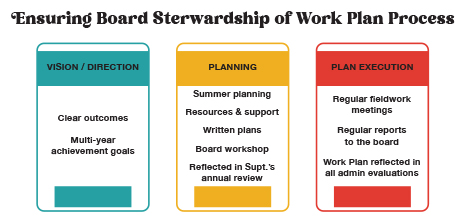
The Work Plan
A Comprehensive Model for Leadership
By David F. Larson, Ed.D.
Superintendent
Glenbard Township High School District 87
The key to fostering a positive culture and climate in any school district lies in strong coherence and alignment between the curriculum, teaching practices and key instructional initiatives.
All too often, districts fail to build systems and structures that ensure consistency in the curriculum, clarity on the level of rigorous coursework and which targets are necessary for the student’s college and career readiness. Unfortunately, this is true of many high schools across the country. While students are expected to take specific courses towards graduation, there is little agreement on the course sequence, the depth of the content and how student learning will be assessed. These districts lack synergy between teachers and departments, which results in a lack of coherence and ultimately contributes to low staff morale. Without systems and structures in place to calibrate around coursework, rigor, teaching practices and student outcomes, teachers drift and feel isolated.
At Glenbard District 87, we ensure that teaching and learning are the key focuses of our strategic work. We have an annual planning process centered on district and school improvement called the Work Plan. While there is significant time and effort dedicated to fiscal stewardship, operations, facilities, parent outreach, community relations, etc., we do not make these a part of the Work Plan framework. Annual Work Plan events focus on bringing clarity and planning to our initiatives, which allow our leaders to engage in the adaptive work of moving the district forward.
These six components are the foundational pillars of the Work Plan process:
• Board Stewardship
• Summer Planning
• Principal Leadership
• Implementing to Scale
• Board Goals
• Leverage of Performance Reviews
Each component plays a critical role in ensuring that our strategic focus remains centered on teaching and learning.
Board Stewardship
Each spring, the board and administrative team take time to review, adjust and affirm the Board Commitments and the Board Goals documents. These guiding documents were first developed in 2013 and are reviewed annually. This becomes an essential routine for the board that allows them to be clear about “what” is most important, a critical step to good stewardship and governance. The Board Commitments and the Board Goals become the district’s expected achievement outcomes. Next, the administrative team determines the “how” through careful planning and execution. This annual ritual of governance oversight provides the administration with clear direction and authority.

Summer Planning
The summer planning days are the most essential and foundational part of the Work Plan process. These days are held early in the summer to ensure focus and avoid distractions inherent to managing a school day. All administrators, including principals, assistant principals, deans, department chairs and district teaching and learning staff, actively participate in this planning.
First, administrators build strong convictions and agreements on what the priorities and objectives are for the next year through thorough discourse. Once agreed upon, a draft of the district’s Work Plan is developed. The Work Plan document referenced at the end of this article shows three areas that represent extensive multi-year work. Objectives are drafted under each Work Plan area and represent an event, program or initiative that is deployed to advance that specific Work Plan area. Tactic and action steps are then identified to support
that objective.
Each principal and their leadership team mirror this structured process by developing a building-level Work Plan aligned with the district Work Plan. Following this, both district office and building administrators create individual Work Plans that align with both the district and school-level plans. This process of individualized planning fosters a strong sense of ownership, commitment and autonomy among leaders at all levels.
Principal Leadership
The success of the Work Plan relies on building principals who are strong instructional leaders. The summer Work Planning process fosters a reciprocal relationship between building and district office administrators centered on accountability and support. Both building and district administrators are accountable for advancing the objectives of the Work Plan while supporting each other in accomplishing these objectives.
The school staff and faculty impacted by these necessary changes must believe that their direct building principal is “all in” and committed to the changes necessary to improve curriculum, instruction and student outcomes. Everyone must have “skin in the game” to advance the Work Plan and achieve the desired goals. This necessary system dynamic of reciprocal accountability requires the building principal to embrace the role of being the building’s instructional leader. Contrasting this with the technical skills needed for managing a well-run building, advancing the Work Plan objectives requires the principal to have adaptive leadership skills, including the ability to change hearts and minds.
Implementing to Scale
Initiatives that are implemented to scale across a building and district have the most notable improvements in student outcomes.
It is common for school districts to showcase a unique, innovative program that is designed to boost student achievement of a select group of students. These programs are wonderful, but they are not reflective of the large-scale change that can benefit all students. The Work Plan process is intended to have a system-wide impact that will result in positive outcomes for all students. Initiating and leading this type of change in a large comprehensive high school can become precarious and difficult, and it requires a system or theory change – like the Work Plan model.
Board Goals
It is critical to establish board goals centered on student achievement as a core anchor of the Work Plan framework. These goals should be on a one-page scorecard and public-facing. Having agreed upon student outcomes gives purpose, meaning and credibility to the significant planning and execution work that teachers and administrators will be undertaking in the year ahead. The parents and general public must also acknowledge, understand and respect the student outcomes.
Each of our nine board goals is clear, easy to understand and well-respected by the entire community. The five that are centered on student achievement include passing rates, rigorous course sequences, early college course experience, college credits earned and proficiency score on the SAT (now ACT). These metrics are not lofty or confusing. The community, specifically the students and the parents, fully understand and respect each goal. These achievement metrics are important to each student and have credibility as the planning and execution work is implemented to scale.
Leverage of Performance Reviews
The final necessary component of the Work Plan framework is ensuring that it is reflected in each administrator’s annual performance review.
Common performance criteria in many administrator evaluations are typically outlined in published state standards, specific job descriptions and assigned duties. Unfortunately, what often is not included in an administrator evaluation instrument is measuring their effort and success in advancing the district and building Work Plans. Without this important accountability link between the daily and weekly work of district administrators and the important work of the Work Plan, there will be drifting and a lack of coherence within the district. The evaluation process should become a key mechanism for integrating accountability within school districts and ensuring organizational alignment.
Without the strong coherence and careful planning that the Work Plan framework provides, administrators and staff can be left feeling anxious and unclear about the direction of the district. If we want to have a strong culture in our districts, we need to take the time to be clear about what we are all trying to achieve. This will result in more collective efficacy and a better sense of belonging for everyone in the organization.
Schools are constantly striving to create an environment where educators feel fulfilled and inspired in their roles. This sense of purpose comes alive when we collaborate as a team, focused on goals that directly benefit our students and make a lasting impact on their lives. By fostering these conditions, we naturally cultivate a positive culture and climate that empowers both teachers and students to thrive.
Here at Glenbard, our strong culture of collaboration has allowed us to increase student achievement in the following areas:
• Glenbard District 87 students who enroll in a 4-year college have a 91 percent graduation rate, compared to 63 percent nationally.
• 98 percent of the Class of 2024 had a personalized plan for after graduation.
• 80 percent of our students enroll in 2-year or 4-year colleges, compared to 62 percent nationally.
• Our average SAT score is 57 points above the Illinois state average.
• Glenbard students earn college credit through AP at rates nearly twice the state and national average.
• Since 2016, we have had 11,493 AP enrollments by historically underrepresented students of color and students from low-income households.
• 62 percent of students graduate with earned college credit in at least one course.
Resources
For further reference and to explore the concepts outlined in this article, the following resources are provided from Glenbard Township High School District 87.
Board Commitments: As mentioned in the Board Stewardship section, this document outlines the guiding commitments reviewed annually by the board and administrative team to ensure clarity and focus.
Board Goals: Referenced in the Board Goals component, this scorecard highlights the district’s public-facing student achievement goals that anchor the Work Plan framework.
Work Plan: This visual document, described in the Summer Planning section, shows the three major Work Plan areas and their aligned objectives, tactics and action steps.
Work Plan Process: As discussed throughout the article, this overview captures the structured annual process that supports coherence, collaboration and accountability across all leadership levels.